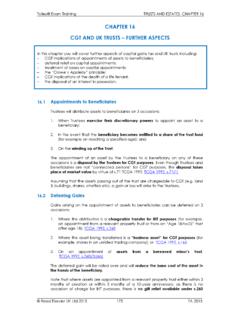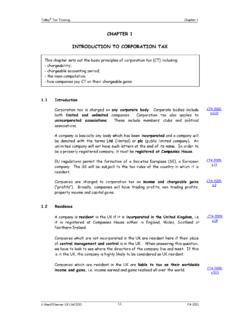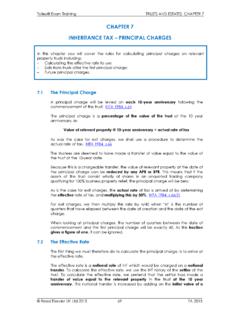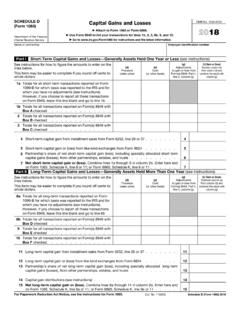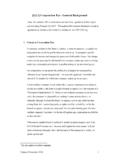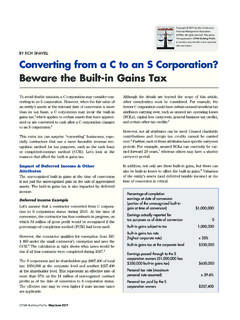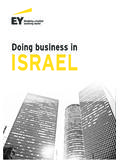Transcription of CHAPTER 15 CAPITAL GAINS AND UK TRUSTS
1 Tolley Exam TrainingTRUSTS AND ESTATES CHAPTER 15 Reed Elsevier UK Ltd 2015159FA 2015 CHAPTER 15 CAPITAL GAINS AND UK TRUSTSIn this CHAPTER you will cover the basic rules for CAPITAL GAINS in connection with UK TRUSTS including: Creation of a trust and the availability of gift relief; Sales by Trustees; Entrepreneurs' relief and PPR relief; Interaction with IHT PrinciplesThe way a settlor creates a UK trust , is by settling transferring assets into the trust . Assuming the assets transferred are not cash, the settlor is making a disposal at market value for CAPITAL GAINS tax purposes. As the settlor and the trustees are connected persons , all transactions are deemed to take place at market value. In absence of any claims, the settlor will therefore be left with a chargeable gain . TCGA 1992, ; TCGA 1992, (3)A transfer by a settlor to a trust will be a disposal at market value even if the settlor is a beneficiary of the trust that he or she sets up.
2 TCGA 1992, certain instances the trustees can claim gift relief to defer all or part of the CAPITAL the Trustees consider it prudent to do so, they will sell trust assets and hope to make a profit. Therefore if they make a CAPITAL gain on settled property, the Trustees, as a chargeable person in their own right, will be subject to CGT. Those GAINS will be reported on the trustees self-assessment return, and CGT will be paid in the normal way. Remember that Trustees are treated as a single and continuing body of persons, distinct from the individual trustees themselves. A change in the composition of the Trustees will have no effect for CGT purposes. TCGA 1992, can also pay CGT on the transfer of an asset to a beneficiary. If the Trustees distribute an asset to a beneficiary, they are deemed to have disposed of the asset at market value and a CAPITAL gain could arise.
3 We shall look at this, and other special situations, in the next of a TrustAssume a settlor transfers shares to a UK trust . The shares have a market value of 200,000 at the date of the gift. A gift to a trust is a disposal by the settlor at market value, so we deduct cost to arrive at the CAPITAL gain in the normal way. Market value200,000 Less: Cost (say)(120,000)Gain80,000 As is the case for all gifts, the donee the Trustees is deemed to have acquired the shares with a base cost equal to their market value at the date of Tolley Exam TrainingTRUSTS AND ESTATES CHAPTER 15 Reed Elsevier UK Ltd 2015160FA 2015the settlement. In certain instances, gift relief can be claimed by the settlor to defer this CAPITAL gain of 80, ' base cost: Market value at gift200,000 Less: Deferred gain (80,000)Base cost120,000 The way we calculate the CAPITAL gain and the gift relief is the same as we do for individuals.
4 We simply calculate the CAPITAL gain assuming a deemed disposal by the settlor at market value, and give gift relief where CAPITAL GAINS tax rules for UK TRUSTS are virtually identical to the CGT rules for UK individuals. Therefore, if in doubt, always go back to basic CGT rules when answering questions on CAPITAL GAINS tax and ReliefGift relief is available to a settlor either under Section 165 or Section 260 TCGA 1992. TCGA 1992, ; TCGA 1992, settlor can make a claim under Section 165 if he makes a gift of business assets to the trustees. Business assets include: TCGA 1992 , (2)(a) Assets used in a business; TCGA 1992, (2)(b)(ii) Shares in a personal trading company (> 5%); TCGA 1992, (2)(b)(i) Shares in an unlisted trading company; TCGA 1992, (5) Land or buildings qualifying for APR. TCGA 1992, Sch 7(3) TCGA 1992 allows a CAPITAL gain to be deferred where the gift is a chargeable transfer for inheritance tax if the settlor transfers assets to a trust , this is usually a chargeable transfer, so any gain can be deferred under s.
5 260. Therefore CAPITAL GAINS arising on the gift of any asset to a trust will normally qualify for gift relief. TCGA 1992, exceptions to this are settlor transfers assets to either a bare trust or a disabled person s trust . As these transfers are PETs for IHT purposes, no gift relief is available under Section 260. GAINS can only therefore be deferred if the assets being transferred are business assets under Section 165; or settlor transfers assets to a non-resident trust . In this case no gift relief claims are allowed. gives relief where the transfer is chargeable to inheritance tax. There is no requirement for inheritance tax to actually have been paid for a gift relief claim to be , for example, if a settlor makes a gift to a discretionary trust and the transfer is covered either by the settlor's nil band or business property relief etc, Tolley Exam TrainingTRUSTS AND ESTATES CHAPTER 15 Reed Elsevier UK Ltd 2015161FA 2015even though no IHT is payable, a gift relief claim can still be made for CGT purposes.
6 TCGA 1992, (2)(a)If both and relief are potentially available, has priority. TCGA 1992, (3)(d)In most instances, a gift relief is a joint claim to be made by the donor and the donee. This is not the case when the donee is a trust . Therefore if the settlor transfers assets to a trust and wishes to defer the gain , the claim will be made by the settlor only, and the consent of the trustees is not required. TCGA 1992, (1)(b); TCGA 1992, (1)(c)A gift relief claim must be made within 4 years after the end of the tax year in which the assets were , for gifts in 2015/16, a gift relief claim must be made no later than 5 April 2020. TMA 1970, that a gift relief claim is not automatic, so if the settlor's GAINS are either covered by losses or his annual exemption, no claim will be made and the Trustee's base cost will not be Relating to Gift Relief ClaimsFinance Act 2004 introduced two rules which restrict the availability of gift relief in certain to settlor-interested TRUSTS : It is not possible to make a gift relief claim on a gift into a trust if the settlor of the trust has an interest in the trust .
7 TCGA 1992, An interest in the trust means that trust property can be paid or applied for the benefit of the settlor or his spouse/civil partner or minor child (under 18). Additionally, there is a clawback of gift relief if the trust is not a settlor interested trust when the gift is made and gift relief is claimed, but the trust becomes a settlor interested trust within six tax years. TCGA 1992, relief: The general rule is that principal private residence relief is available to Trustees if a beneficiary occupies a trust property as his only or main residence. TCGA 1992, From 10 December 2003 it is not possible for Trustees to claim PPR relief if a gift subject to a Section 260 gift relief claim has been made previously. This is discussed in more detail later in this CHAPTER . by TrusteesTrustees are a chargeable person in their own right with a distinct legal personality, and they will pay CGT in the same way as an Exam TrainingTRUSTS AND ESTATES CHAPTER 15 Reed Elsevier UK Ltd 2015162FA 2015 Trustees will dispose of assets if they consider it to be in the interest of the beneficiaries to do so.
8 If Trustees dispose of trust assets at a profit and make a CAPITAL gain , normal CGT rules will apply. TCGA 1992, a Trustee acquires an asset from the settlor, the base cost of the asset is equal to the market value at the date of the gift, reduced by gift relief if a claim is made under either or calculate CGT payable by Trustees, we use the rules which apply for individuals, with one minor receive an annual exemption which is equal to half of an individual's exemption. TCGA 1992, Sch 1 Para 2 (2)Therefore for 2015/16, the Trustee's annual exemption is 5, is an anti avoidance rule to prevent a settlor setting up a number of TRUSTS and claiming an annual exemption for each of those TRUSTS . The annual exemption of 5,550 is divided by the number of UK TRUSTS settled by the same settlor after 6 June 1978. Overseas TRUSTS and TRUSTS which are no longer in existence are if a settlor created 2 UK TRUSTS , each trust will receive an annual exemption of 2,775.
9 Where the anti avoidance rule applies, the minimum annual exemption given to each trust is 1,110. This is equal to one-tenth of an individual's annual exemption. TCGA 1992, Sch 1 Para 2 (3)The rate of CAPITAL GAINS tax applying to GAINS made by Trustees is 28%.If Trustees sell assets and make a loss, normal loss rules apply. The Trustees must first set losses against GAINS of the same tax losses are carried forward against future CAPITAL GAINS . Trustees cannot carry back a CAPITAL loss. Illustration 1 The Ashley Family trust sold the following assets in 2015/16: A painting on 30 April 2015 giving rise to a gain of 20,000; Shares in BP plc on 1 June 2015 giving rise to a loss of (15,000); and An investment property on 31 October 2015 giving rise to a gain of 50,000. Calculate the CGT payable by the Trustees. Painting20,000 Investment property50,000 Less: Loss on shares(15,000)Chargeable gains55,000 Less: AE(5,550)Taxable gains49,450 CGT @ 28%13,846 Tolley Exam TrainingTRUSTS AND ESTATES CHAPTER 15 Reed Elsevier UK Ltd 2015163FA ' ReliefEntrepreneurs' relief is a CGT relief available to taxpayers who sell or give away their aim of entrepreneurs' relief is to reduce the rate of CAPITAL GAINS tax paid by taxpayers on qualifying disposals to 10%.
10 GAINS are eligible for entrepreneurs' relief up to a maximum lifetime limit which is currently 10 million (discussed later).Relief is given by taxing GAINS qualifying for entrepreneurs' relief at a flat rate of 10%. Entrepreneurs' relief is available where a disposal is made by a qualifying trust . In order for an entrepreneurs' relief claim to be made in respect of trust GAINS , the beneficiary must have an interest in possession in the trust . Fully discretionary TRUSTS therefore will never be able to claim entrepreneurs' relief. TCGA 1992, (3)The disposal must either be business owned by the trustees but run by the beneficiary (either alone or in partnership); or (more likely) in a qualifying company. The qualifying company must be the beneficiary's personal trading company (ie 5%+) and the beneficiary must be an employee or officer of the company.
